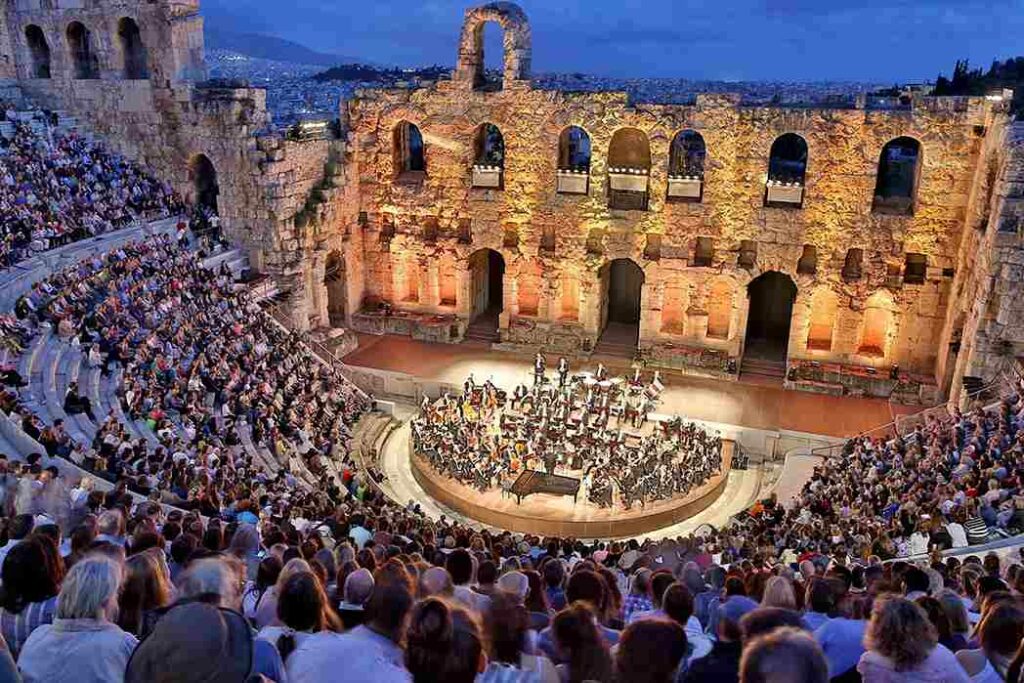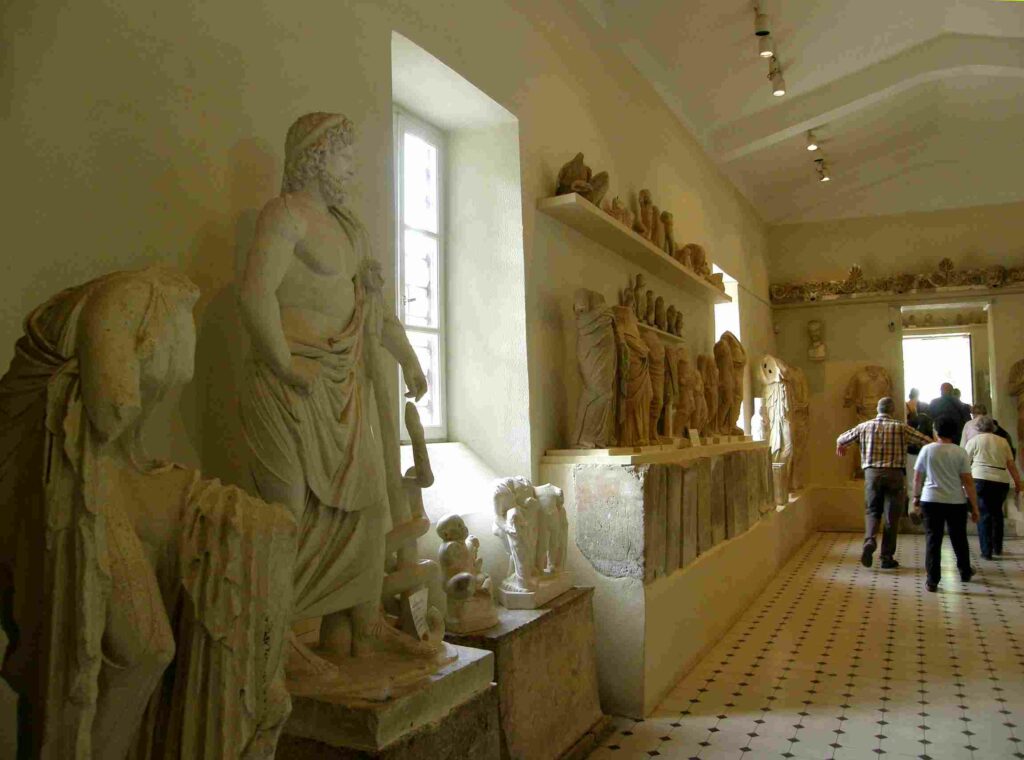Located on a hilltop above the Sanctuary of Asclepius, the Theatre of Epidaurus dates back to the fourth century BC and has been meticulously conserved. Everyone in the audience of 14,000 could hear every word of every act because of the venue’s exceptional acoustics.
Table of Contents
The Epidaurus Theater’s Remarkable Acoustics
Since its inception, the ancient Epidaurus theatre’s remarkable acoustics have been the subject of much inquiry. There is a common belief that even those in the very last row of a concert hall can hear the music and voices of the artists. At first, the theatre’s unrivalled acoustics were thought to be the result of its placement on the 26-degree inclination of Mount Kynorthio. However, research conducted in 2007 by the Georgia Institute of Technology found that although the location is important, the seats themselves are the primary factor.
The stone stairwell reduces ambient noise and produces a phenomenon known as “virtual pitch,” improving the audibility and quality of the incoming sound. As a bonus, the space between each row of chairs allows the sound to spread evenly. The high-quality marble utilised, the lack of background noise, the peaceful setting, and the continual wind flowing from the orchestra towards the spectators all contribute to the excellent acoustics.
The Epidaurus Theater’s Reputable Sound System
The Theater of Epidaurus, like many other ancient amphitheatres, is said to offer unparalleled sound quality. However, the theatre at Epidaurus is justifiably the most well-known of all the antique theatres. It is reported that if you drop a coin in the middle of the stage, you can hear it from the final stand. We only know a little about how the ancient Greeks broadcast sound. Placing extra things surrounding the theatre, such as empty containers, would have helped transmit sound farther.
To check the theatre’s acoustics, visitors should toss a coin in the middle of the marble stage and see whether the person at the very top can hear it clearly when on a day trip from Athens to the Ancient Epidaurus theatre. You may also try singing a love song or whispering sweet nothings to your partner to see if it helps.
There is a semicircular area around the orchestra (called the ‘koilon’ since it was originally named after a dance that is sung and danced) where the audience sits and a circular orchestra (called the ‘chorus’) where the actors and dancers perform. The bottom moulding of the ‘koilon’ is reserved for priests and lords, while the top moulding, reserved for the people, has 21 rows of seating. The 20-meter-wide orchestra is encircled by a 1.99-meter-wide subterranean sewer designed to collect runoff from the koilon.
Much has been said about ancient Greek theatre‘s status as the pinnacle of artistic achievement. The best theatre from that era has the power to stir your emotions and impart lifelong lessons about the human condition. If you believe yourself to be a theatre enthusiast, then a trip to the historic theatre of Epidauros is not only recommended, it is necessary for your cultural development.
Take advantage of a day excursion to Argolis to see the ancient theatre of Epidauros, a location crucial to the development of Greek play. The mythological exploits of young readers’ favourite fictional hero, Percy Jackson, may provide hours of entertainment on a family vacation to ancient Corinth and Epidaurus.
Theatre of Epidaurus, an Ancient Greek Amphitheater
As An Offering To The Gods
Almost every action in ancient Greece was performed with reverence for the gods. In this way, going to the theatre was a pleasurable pastime and served a greater good. The theatre was built as a tribute to the Greek god Asclepius. Asclepius, Apollo’s son and the Greek deity of health and medicine is honoured at this ancient site.
Incredible Acoustics
You supposedly will get a peep from your seat at the rear of the Epidaurus theatre. This may be an exaggeration, but the acoustics of such an antique theatre are quite remarkable. Actors in this theatre don’t need to use microphones since the seating arrangement eliminates their necessity.
According to research, the theatre’s seats play a significant part in the auditorium’s acoustics because “the seats, which create a corrugated surface, function as an acoustic filter that passes noise coming from the theatre at the price of surrounding acoustic disturbance…” The theatre at Epidaurus was constructed with optimal design and size, which may or may not have been intentional.
In Honour Of Epidaurus And Its Festival

Each year in the summer, Athens and Epidaurus host one of the biggest festivals in all of Greece: the festival. Some performances occur in Athens, in others of the many wonderful venues spread out around the city, while some take place at Epidaurus, at the ancient theatre. In its current incarnation, the festival has been operating continuously since 1955, marking it the longest-running event of its kind in Europe.
The festival celebrates the history of the ancient theatre in Epidaurus via various performances, including plays, musicals, and dance. Many people around the globe visit Greece to experience this newly rediscovered artistic tradition. If you are on vacation in Greece right now, you should check out the world’s oldest theatre and get a flavour of Greek culture!
See A Museum

Even though it’s on the smaller side, the Archaeological Museum of Epidaurus is a great accompaniment to a trip to the Sanctuary or the old theatre. On-site displays include several artefacts unearthed in this area, many of which were uncovered by Kavvadias himself. Statues of Asclepius may be found among the ancient world’s inscriptions, ceramics, and artefacts.
Locational Features of Epidaurus
Near the old theatre, you will find the following attractions at the archaeological site:
Temple of Asclepius: The Temple of Asclepius, dedicated to Apollo’s son and the Greek healing deity, was one of the country’s holiest sites. Some columns are still upright, although just a fraction of the original number remains.
Tholos: The Tholos is a columned, white marble, circular structure. It was likely a temple, although that has yet to be proven.
Stadium: Evidence of a stadium built in the fifth century is still there. There used to be athletic events at the stadium.
The Epidaurus Archaeological Museum is a modest museum that displays artefacts unearthed from the ancient Greek city of Epidaurus.
Amazing And Enchanted Acoustics May Be Found At The Epidaurus Theatre
The historic theatre’s secret ingredient, discovered by Georgia Tech researchers, is its remarkable acoustics. It’s the chairs, not the hill or the wind. The limestone benches in the Epidaurus theatre create an effective acoustics filter, dampening out low-frequency noises like the hum of a crowd while reflecting the high-frequency sounds of the performers toward the audience. This allows an actor’s voice to be heard even in the farthest seats in the house.
According to ScienceDaily, the work of Nico Declercq, an assistant professor in the Woodruff School of Mechanical Engineering at Georgia Tech and Georgia Tech Lorraine in France, and Cindy Dekeyser, a technologist who is fascinated by the history of ancient Greece, will be published in the April issue of the Journal of the Acoustics Society of America.
The seats themselves were the key to the acoustics success of the ancient theatre of Epidaurus, which professionals did not widely suspect despite much speculation about the likely reasons. Some thought the wind, which blows largely from the theatre to the audience, was to blame, while others thought it was the masks, which may have worked as rudimentary loudspeakers or the cadence of Greek speech. Other, more technical explanations accounted for the slant of the aisles and rows of seats.
Conclusion
Epidaurus is celebrated yearly in its historic theatre on the hillside, constructed in 45 BC (more than 2,500 years ago). This multi-level, circular theatre can accommodate over 18,000 people. If you stand in the middle of the theatre’s circle, you will be able to hear a pin drop in the furthest seats. The application of architectural design in early audio equipment allowed breakthroughs in performance that are unfathomable today.














